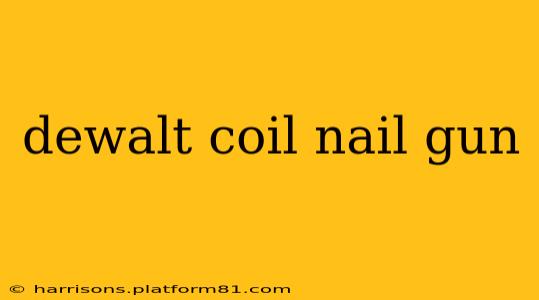DeWalt coil nail guns are a staple in construction and woodworking projects, offering speed, efficiency, and reliability. Whether you're a seasoned professional or a dedicated DIYer, understanding the nuances of these tools is crucial for achieving optimal performance and safety. This guide dives deep into the world of DeWalt coil nail guns, exploring their features, benefits, applications, and maintenance.
What are the Different Types of DeWalt Coil Nail Guns?
DeWalt offers a range of coil nail guns catering to various applications and material types. The key distinctions often lie in the type of nails they use (framing, finishing, etc.) and their power source (pneumatic or cordless). Some popular models include those designed for framing, flooring, and finish work, each with specific nail sizes and driving capabilities. Knowing the differences is vital for selecting the right tool for your project. For example, a framing nail gun will be significantly more powerful than a finish nail gun, reflecting the differing demands of each application.
What are the Advantages of Using a DeWalt Coil Nail Gun?
The advantages of choosing a DeWalt coil nail gun are numerous. Compared to stick nail guns, coil nail guns boast significantly faster loading times, reducing downtime and boosting productivity. The continuous feeding system allows for uninterrupted work, making them ideal for large-scale projects. DeWalt's reputation for durability and reliability ensures a long lifespan with minimal maintenance. Their ergonomic designs prioritize user comfort, even during extended use, reducing fatigue and improving precision.
How Do I Choose the Right DeWalt Coil Nail Gun for My Needs?
Selecting the right DeWalt coil nail gun depends heavily on the specific project. Consider the type of material you'll be working with (wood, metal, etc.), the size and type of nails required, and the scale of the project. Framing projects necessitate a powerful framing nailer, while finish work demands a more precise finish nailer. Assessing your budget and whether you need a pneumatic or cordless option are also essential considerations. Reading detailed product specifications and user reviews can provide valuable insights before making a purchase.
How Do I Maintain My DeWalt Coil Nail Gun?
Regular maintenance is critical for prolonging the life and performance of your DeWalt coil nail gun. This includes regularly cleaning the tool, lubricating moving parts, and inspecting for any damage. Ensuring the air hose (for pneumatic models) is clean and free from kinks is also important. Refer to your tool's manual for specific maintenance instructions, as proper cleaning and lubrication practices vary across different models.
What Safety Precautions Should I Take When Using a DeWalt Coil Nail Gun?
Safety should always be the top priority when using any power tool. Always wear appropriate safety glasses and hearing protection. Ensure the work area is clear of obstructions and that you have a firm grip on the tool before firing. Never point the nail gun at yourself or others. Regularly inspect the nail gun for any damage or malfunctions, and discontinue use if any issues are found. Familiarize yourself with the tool's safety features and instructions before operation.
Are DeWalt Coil Nail Guns Worth the Investment?
For professional contractors and serious DIY enthusiasts, the investment in a DeWalt coil nail gun is often worthwhile. The speed, efficiency, and reliability offered by these tools justify the initial cost in terms of increased productivity and long-term durability. The reduced downtime and improved ergonomics also contribute to a positive return on investment. However, if you only have occasional small projects, a less expensive option might suffice.
What is the difference between a DeWalt coil nailer and a DeWalt pin nailer?
A key difference lies in the size and type of fasteners used. Coil nailers utilize longer nails, typically ranging from 1 1/4" to 3 1/2", ideal for framing, sheathing, and other heavy-duty applications. Pin nailers, on the other hand, use much smaller pins, typically less than 1 inch, making them suitable for finer finish work. Pin nailers are designed for precision and aesthetics and may not be appropriate for tasks requiring heavy-duty fastening.
What are the common problems with DeWalt coil nail guns and how can I fix them?
Common issues include jams, misfires, and insufficient driving power. Jams often occur due to bent nails, debris, or improper loading. Misfires can result from low air pressure (for pneumatic models), insufficient battery charge (for cordless models), or damaged internal components. Insufficient driving power may indicate a problem with the tool's air pressure regulator or internal mechanisms. Consulting your owner's manual for troubleshooting advice and checking for bent nails or debris are good starting points. If problems persist, contact DeWalt's customer service for assistance.
This comprehensive guide provides a thorough overview of DeWalt coil nail guns. Remember to always prioritize safety and consult your tool's manual for specific instructions and maintenance procedures. With proper care and understanding, your DeWalt coil nail gun will be a valuable asset for years to come.
